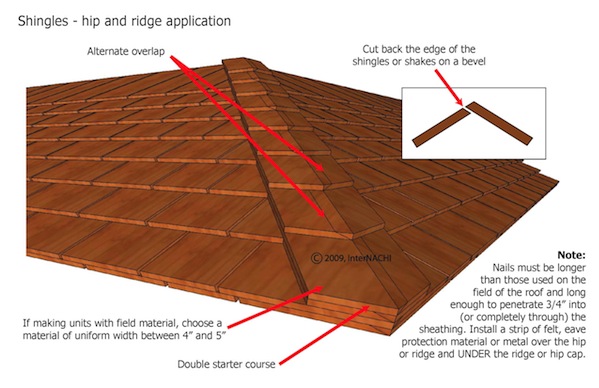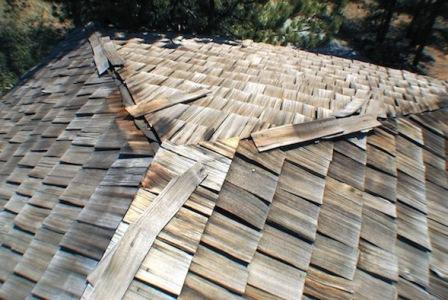Mastering Roof Inspections: Wood Shakes and Shingles, Part 6
by Kenton Shepard and Nick Gromicko, CMI®
The purpose of the series “Mastering Roof Inspections” is to teach home inspectors, as well as insurance and roofing professionals, how to recognize proper and improper conditions while inspecting steep-slope, residential roofs. This series covers roof framing, roofing materials, the attic, and the conditions that affect the roofing materials and components, including wind and hail.
Workmen
A variety of different kinds of damage can be done by those working on a roof. The roof may be walked on for a variety of reasons, including for maintenance on the gutters, chimney and roof, and for work on other components, such as air-conditioning, electrical, HVAC and communications equipment. Splitting is the type of damage of main concern.
Chemical
Chemicals may be applied to a wood roof for a number of reasons. People may try to extend the life of the roof, make it more fire-resistant, and remove and prevent biological growth by applying a wide variety of chemicals, some of which are inappropriate and some of which are damaging to the roof.
ENVIRONMENTAL PROBLEMS
Biological Surface Growth
Various types of biological organisms will grow on wood roofs if conditions are right. These include moss, lichen and algae. Their presence on a roof indicates elevated moisture levels. Moss and algae, especially, will hold moisture against the roof, encouraging decay. Zinc or copper strips may be nailed across the roof near the ridge to help prevent algae growth. Copper is generally more effective and sometimes will kill existing algae. Moss has shallow roots and can be removed by scrubbing.

Stay off mossy wood roofs. Moss on wood is slippery!
Algae are more difficult to remove, and chemicals may be required to kill it. In your report’s wording, you should recommend that “appropriate” chemicals be applied by a “qualified contractor.” Using the wrong chemicals may discolor the roof or damage or kill landscaping. It may also put toxic chemicals into the soil around the home, which can be especially dangerous to children and pets.
Decay

Wood decay, which is the same as wood rot, is caused by fungi. It often happens in shake and shingle butts first because butts are thicker and hold moisture longer. Because they may contain large numbers of fungi that can spread to and damage the surrounding roof, shakes and shingles with visible decay should be replaced. Heartwood contains extractives that make it more resistant to decay than sapwood. This means that edge-grain shakes and shingles resist decay better than flat-grain.
Decay may be caused by different conditions.
- In some climate zones, wood roofs should be installed over spaced sheathing. Solid sheathing may slow drying enough to allow decay to develop.
- Multiple layers of wood roofing may prevent the roof from drying adequately.
- Improper interlayment and underlayment practices and materials can also slow drying significantly.
- If attic or rafter bay ventilation is poor, the roof may dry too slowly because air movement cannot remove moist air from the attic or rafter bays.
- Shade from trees and mountainous terrain will slow the drying process.

- Debris accumulated on the roof will hold moisture against the wood and encourage decay.
Cap Shakes and Shingles

Cap shakes and shingles are butted together and fastened with nails or staples. Although butt laps should alternate as caps and are installed to help shed runoff properly, this is a quality issue, and it won’t be what you’ll find on the roof when inspecting most homes. Don’t call it a defect if you don’t find caps done this way.
Caps fail in several ways.

- Over time, thermal and moisture cycling will loosen the fasteners that hold caps together. The two halves will start to separate, opening an avenue for moisture intrusion. The same physical processes will loosen the fasteners anchoring the cap shakes and shingles to the roof, making them more vulnerable to uplift. Their position on the ridge and hips also increases the chance that they will be blown off.
- Installers often use the same fasteners for cap shakes and shingles that they use for field shakes. These fasten cap shakes only to underlying shakes, but not to the roof deck. This condition reduces the wind resistance of the caps. Pull lightly on caps to check the fastening.

- Ridge caps should be overlapped away from the prevailing winds. In the photo above, wind blows from the left toward the right. The ridge cap shakes are overlapped correctly. Overlapping caps in the wrong direction will result in failure happening sooner in areas subject to high winds.
**************************************************
Learn how to master a roof inspection from beginning to end by reading the entire InterNACHI series: Mastering Roof Inspections.
Take InterNACHI’s free, online Roofing Inspection Course
Mastering Roof Inspections
Roofing Underlayment Types
Inspecting Underlayment on Roofs
Fall-Arrest Systems
Roofing (consumer-targeted)
More inspection articles like this

